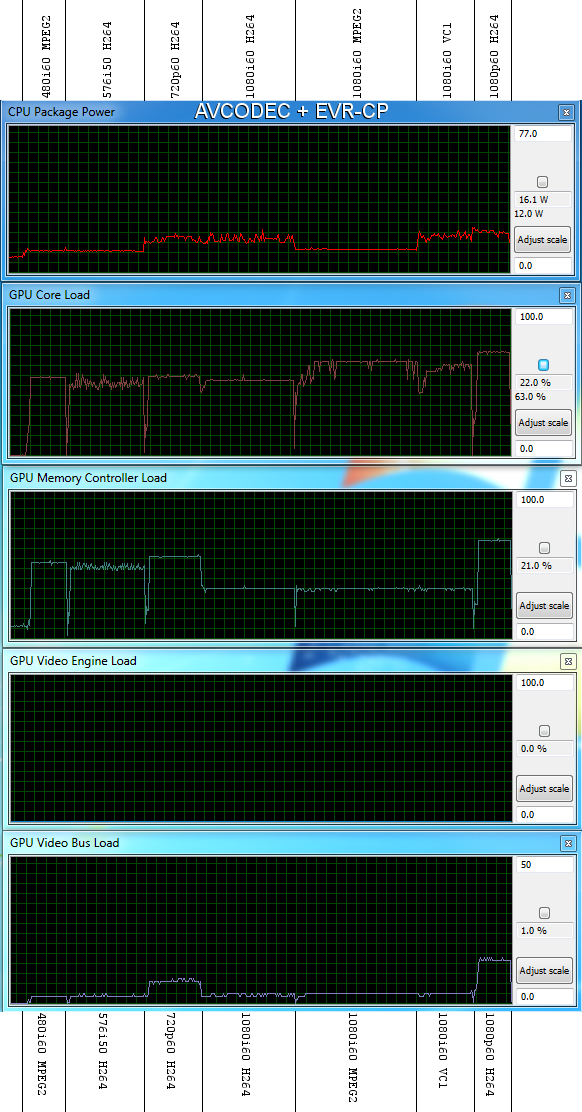Zotac GeForce GT 640 DDR3 Review: Glacial Gaming & Heavenly HTPC
by Ryan Smith & Ganesh T S on June 20, 2012 12:00 PM ESTHTPC Aspects : Decoding and Rendering Benchmarks
We introduced our HTPC decoding and rendering benchmarks in the ASRock Vision 3D 252B review, and also used it in the 4K decode and display section of this review. In this section, we will look at how the system responds to the various test streams under various renderers and decoders. You can roll the mouse over the various entries in the first / last rows of the table below to compare the resource graphs.
Resource Usage Comparison - Software Decode vs. DXVA2 vs. LAV CUVID / EVR-CP vs. madVR
The GT 640 can be made to effectively work with madVR without issues. Unlike GT 540M, it is not necessary to carefully configure madVR to avoid dropping frames. With the queue sizes at the maximum, we were able to go through our rendering test suite in both full screen exclusive and full screen windowed modes without dropping frames.
Starting with this review, we also want to look at the power consumption profile of the system when subject to the rendering benchmarks.
| Zotac GT 640 HTPC Testbed Power Consumption (W) | ||||
| Idle | 51.4 W | |||
| Benchmark Stream | CUVID | avcodec | ||
| EVR-CP | madVR | EVR-CP | madVR | |
| 480i60 MPEG-2 | 67.5 | 70.9 | 58.9 | 69.3 |
| 576i50 H.264 | 67.5 | 67.1 | 58.8 | 57.7 |
| 720p60 H.264 | 69.9 | 74 | 67.9 | 77.8 |
| 1080i60 H.264 | 74.5 | 77.2 | 80.4 | 83.1 |
| 1080i60 MPEG-2 | 73.9 | 76.2 | 71.6 | 77.7 |
| 1080i60 VC-1 | 73.8 | 77.1 | 80.5 | 84.6 |
| 1080p60 H.264 | 72.7 | 76.3 | 74.3 | 85.7 |
madVR does carry a bit of a power penalty. As expected, software decode is more power efficient for lower resolution streams (up to 720p60) / MPEG-2 encodes. CUVID based hardware decode turns out to be more efficient with the 1080i and 1080p streams. Note that the benchmark streams were played off the local primary hard drive. The power consumption (measured at the wall outlet) also includes the hard drive activity.
As our coverage of the Zotac GT 640's HTPC aspects comes to a close, we would like to underline the fact that it is one of the best HTPC cards available in the market right now if madVR capability is a must.
For the general consumer, Intel's HD 4000 based system should be more than enough. However, in terms of looking into the future as well as current software infrastructure available, it is hard to go wrong with the GT 640. If it were not for the shortcomings of the NVIDIA drivers, we would have had no hesitation in crowning the GT 640 as the next undisputed HTPC king.
We are aware of the fact that AMD 7750 is a competitor to the GT 640 in more ways than one. We already covered AMD 7750's HTPC performance here. However, we will shortly be carrying out a review of the Sapphire Ultimate 7750 passively cooled edition using the same metrics considered in this review and the latest drivers from AMD.











60 Comments
View All Comments
extide - Wednesday, June 20, 2012 - link
For posting folding benchmarks! A lot of people really appreciate that!Zink - Wednesday, June 20, 2012 - link
+1No one else uses your benchmarking tool and it doesn't always correlate to performance with current F@H projects but that is the only reason I care about GPUs.
Marlin1975 - Wednesday, June 20, 2012 - link
Good design if it had DDR5. If they can do 2gig of DDR5 then it be a great mid-price card.Homeles - Wednesday, June 20, 2012 - link
It would still be terrible until the price dropped.Samus - Thursday, June 21, 2012 - link
There's no reason this wouldn't be similar in speed to a GTX460 if it had DDR5. The only difference would be 128-bit vs 192-bit memory bus, everything else would be an advantage: same number cores, substantially higher clock speed, lower power consumption increasing overclocking headroom, etc.MrSpadge - Thursday, June 21, 2012 - link
You forget: substantially lower shader clock speed, more coarse shader grouping -> more difficult to use them all at once, and software scheduling -> need a better compiler, can't do runtime optimizations.t_case - Wednesday, June 20, 2012 - link
So who has the Sony VPL-vw1000ES? Now that's a nice projector... only roughly the price of a new car heh.stephenasmith - Wednesday, June 20, 2012 - link
I love me some painfully slow gaming!nitrousoxide - Wednesday, June 20, 2012 - link
Just curious if the most powerful IGP can keep up with entry-level KeplerRoland00Address - Wednesday, June 20, 2012 - link
But this should get you an idea of what performance you would be getting with llano. (Numbers taken from Llano review that appeared 12 months ago so drivers will be old.)Crysis Warhead 1680x1050 performance quality
A8-6550D with 1600 mhz memory
58.8 fps
A8-6550D with 1866 mhz memory
62.5 fps
GT640
99.8 fps
This makes the 640 about 69.7% faster than a non overclock Llano (people are going to get 1600mhz memory).